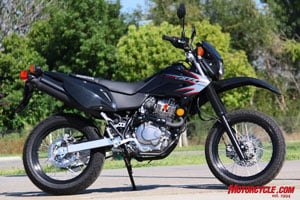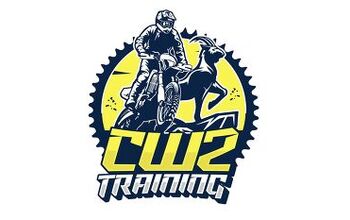2009 Honda CRF230M Review - Motorcycle.com
This supermoto thing is finally gaining a foothold with the giants of the motorcycle industry.
The DRZ400SM has been in the Suzuki lineup for a number of years now. The motard DR is pretty true-to-form of what grassroots supermotos were crafted from: a dirt bike with decreased suspension travel, and made to accept 17-inch wheels in order to wear sportbike-size performance tires.
Kawasaki got in on the game this year with the KLX250SF, the ’09 supermotard-ed version of the KLX250S, and Yamaha’s fuel-injected WR250X is a class gem. Now, Honda follows suit, doing essentially to the CRF230L dualie, what Kawi and Yamaha did with their lightweight multi-purpose motorbikes.
We gave the 230L, powered by an air-cooled, SOHC, 223cc, 6-speed Single fed by a 30mm constant velocity carb, a thorough thrashing last year in our 2008 Lightweight Dual Purpose Shootout. The Honda was down on power in that test, especially to the Kawasaki, but we came away impressed by how capable the CRF proved to be with only 14 rwhp, and of course, its legendary Honda quality.
For 2009 Honda introduced the CRF230M. It is, in essence, the same bike as the off-roadie L model, only with 17-inch spoke wheels fitted with Dunlop GT401 Arrowmax tires in sizes 110/70 x 17 and 130/70 x 17, front and rear. A one-tooth smaller wheel sprocket (38) allows slightly higher speeds on the road compared to the L model’s 13 x 39 sprocket combo.
Both Honda models carry the single-cylinder mill in a sturdy steel-tube single cradle-type frame. Each bike also sports a 37mm Showa fork with 9.0 inches of travel, and each run a pre-load adjustable Showa shock out back, but the motard model’s rear travel is a skosh more at 6.6 inches versus the L model’s 6.3 inches. The supermoto and enduro machines also share a 240mm brake rotor squeezed by a single dual-piston sliding-pin caliper up front; a single-piston sliding-pin caliper grabs a 220mm rear brake rotor.
Though both motorcycles’ 52-plus-inch wheelbase vary by only a fraction of an inch, the CRF230M runs tighter steering geometry biased for quicker handling on the pavement: a 23.9-degree rake and 3.58 inches of trail compared to the CRF230L’s 26.8-degree rake and 4.0 inches of trail.
What’s new with you, Mr. Lightweight Motard?
It’s been just about one year since we rode the 230L, so time on the M model served as a reminder of some of the nicer qualities about this basic Honda platform. An air-cooled 223cc Single doesn’t sound impressive in this day and age, where 1,000cc superbikes are as ubiquitous as “male enhancement” commercials on late-night cable television. But what may come as a surprise is the CRF230M’s ability to loft the front wheel with ease in first gear given a little assistance from the clutch. The gearbox feels taut and has a short throw, making clean, positive shifts a routine thing.
But more impressive than the transmission was the general smoothness of the engine. I’d forgotten in nearly a year just how darn good of a job Honda has done at mitigating vibration from an engine configuration that is otherwise inherently buzzy.
Even with the throttle rapped out in top gear in order to stay just ahead of L.A. freeway traffic, the 230M is smooth for a Thumper, and therefore a pleasure to ride.
In the right conditions the 230 makes just enough power to see an indicated 80 mph, keeping you (mostly!) just out of harm’s way on the highways and interstates of SoCal. And before you ask, no, I wouldn’t recommend any more time on the freeway than absolutely necessary. The bike is, after all, a small-displacement machine. Finally, fueling and throttle response from the basic carb was very good if not flawless.
The suspension’s been tuned with a good amount of compression damping without feeling overly squishy, as a budget-bike's suspension often tends to be. The Dunlop rubber offers plenty of grip for a bike of this displacement and claimed ready-to-ride weight of 276 lbs. The tires have about as ideal a profile as possible with good feedback, neutral handling, and linear and predictable turn-in feel.
A word of warning though: rain groves and other large gaps in the pavement can play havoc with the tires relatively small cross section, particularly when at full boogie, causing the tires to “seek” and the bars to wiggle a little more than you might expect. The trade-off for a less-than-ideal freeway mount is nimbleness. The bike’s lightweight and diminutive stature means it’s capable of darting through traffic or the tight confines of a parking lot like a dragonfly with wings of fire.
Better Late Than NeverWhen we say supermoto, we’re referring to the recent form of the sport and motorcycles, not the made-for-television spectacle, Superbikers, created by Gavin Trippe that aired on ABC’s Wide World of Sports in the late 1970s through the mid-'80s.
Unfortunately, after airing for several years, Americans didn’t latch on to the idea of supermoto, and interest in the hybrid form of racing fizzled out. However, our French bike-loving comrades picked up on it and have enjoyed supermotard (French translation of Superbiker) for a long time now.
Supermotard, or supermoto, as we know it now in the U.S. is largely the result of Cycle World’s Don Canet’s STTARS (Super TT American Racing Series); the series’ humble beginnings date back over 10 years. Word of the fun to be had at races spread like wildfire, and with each new event more and more riders eager to sample the re-birth of this mult-discipline form of riding filled the STTARS grid. Further evidence of the sport’s appeal was the AMA’s establishment in 2003 of a national supermoto series that attracted names like Jeff Ward, who’s still active racing today, Ben Bostrom, Mike Metzger, Doug Henry and Carey Hart, to name only a smattering of the talented racers drawn to supermoto.
We could go on and on about other top-level riders that crossed over to supermoto, or how numerous big name brands glommed on to the sport, but at this point we figure supemoto’s size and popularity is obvious.
So, it only took about a decade-plus for major OEMS to catch the drift, with KTM being an exception. As the saying goes, better late than never.
What the front brake lacks in Brembo-like stopping force it more than makes up for in the form of feedback. Good sensitivity is often hard to come by in sliding-pin type calipers. The rear disc brake performs well enough, but I’ve experienced better stopping power in some lower-tech drum brakes.
Some other highlights we enjoyed are the removable rubber inserts (good for reducing vibes) in the off-road-style footpegs and a Renthal handlebar.
What is ultimately an asset for a bike in this market is the rather low but welcoming 31.7-inch seat height. For the new, female or shorter-inseam rider, this is a boon. However, anyone with a 30-inch inseam or longer might find the little CR feeling almost too small at times. It’s always a treat to come to a stop and plant both feet solidly on terra firma, but I guess my decades worth of riding experience made me prefer something with a little more height and legroom.
This is a Honda, so it’s hard for us to say this, but all is not ideal (note we didn’t say perfect!). Essentially, what we’re talking about here is really nit-picky and entirely subjective, but the bike’s styling could use some modernizing. For instance, the square headlight simply looks outdated. And the full-size amber turn signals, as well as the full-size tail/brake light come across as slightly out of proportion to the rest of the bike, not to mention looking rather 1990s.
Also, the buzzard beak full-on motocross fender could be scaled down a tad. And would it be too much to ask to figure out a way to throw in a tachometer and maybe a locking fuel cap?
Indeed, the quality of the CRF230M is unquestionable and easy to recognize in the high-quality surface finishes of the frame, swingarm and engine. Or how Honda has taken the time to discreetly mask unnecessary details like the carb’s push-pull cable mechanism. From the instrument cluster to the quality feel and action of the switchgear, and even to the passenger footpegs, attention to the small stuff isn’t left behind on this motorcycle despite the constant forward march for maximum profitability.
Then again, it’s the apparent profit margin on the CRF230M that makes us scratch our heads. It’s my notion that an air-cooled single-cylinder bike with an MSRP of $5,399 probably should have those missing little extras or updates I whined about above, and then some.
Kawi’s lightweight motard KLX250SF (and sibling dual-purpose scoot) offers more displacement, liquid-cooling, higher-spec suspension and an LCD instrument cluster for an MSRP precisely $100 less than the CRF230M.
In light of the disparity between the bikes and their prices, we’re left to keep scratching our heads, asking what was it Kawasaki, a company with lower production numbers than Honda, was able to do that Big Red couldn’t?
Related Reading
2008 Lightweight Dual-Purpose Shootout
2009 Kawasaki KLX250SF Review
2008 Honda CRF230L Review
2009 Qlink XF200 Review
Quarter-Liter Supermoto Shootout
More by Pete Brissette


































Comments
Join the conversation